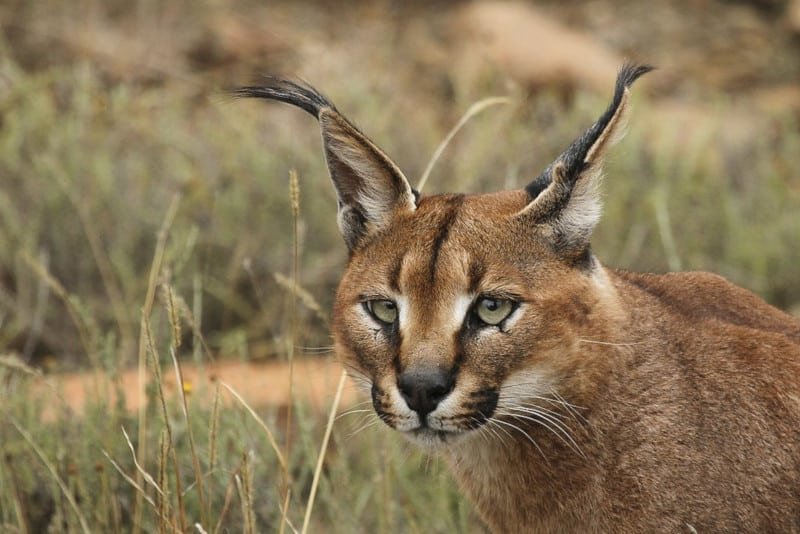
The Caracal is one of those wild animals that captures your imagination the moment you see it. Picture a sleek feline with tufted ears, piercing eyes, and a beautiful tawny coat. This medium-sized cat roams the African savannas, open woodlands, and rocky hills. Although they might remind you of a small lynx, they have their distinct charm that makes them stand out in the wild.
These captivating creatures are not just pretty faces; they are known for their impressive hunting skills and adaptability. Caracals can leap up to 10 feet in the air to catch birds mid-flight. Can you imagine the thrill of watching that? Yet, despite their remarkable agility and hunting prowess, they often remain a mystery to many. Let’s peel back the layers on this remarkable wild cat.
Physical Characteristics
Caracals are medium-sized cats, averaging about 40 to 50 centimeters (16 to 20 inches) in height at the shoulder. They typically weigh between 8 to 19 kilograms (18 to 42 pounds). Their sturdy build features long legs and powerful muscles, allowing them to sprint at remarkable speeds when pursuing prey.
One of their most striking traits is their large, tufted ears. These tufts can be about 4 centimeters long and help enhance their hearing. The Caracal’s large ears are perfectly designed to catch even the faintest sounds of their prey. Coupled with their acute sense of sight, these cats are formidable hunters. The soft, reddish-brown to golden fur of their coats helps them blend seamlessly into the dry grasslands where they thrive.
Habitat and Distribution
Caracals are versatile cats found across various regions in Africa, the Middle East, and parts of Central Asia. They prefer habitats that offer open spaces, such as savannas, semi-arid regions, and scrublands. You won’t typically find them in dense forests, as they thrive in environments that allow for stealthy movement and hunting opportunities.
One interesting fact is that Caracals can adapt well to human-modified landscapes, often establishing territories near agricultural areas. This adaptability allows them to thrive in changing environments, but it also puts them at risk due to habitat loss and conflicts with farmers. Understanding their habitat preferences provides insight into how we can coexist with these extraordinary creatures.
Diet and Hunting Behavior
The Caracal is primarily a carnivore, and its diet is as varied as its habitat. They prey on small to medium-sized animals, including rodents, birds, and even small antelopes. Their incredible hunting skills are characterized by stealth and agility. Caracals often stalk their prey before launching themselves into the air to catch it, making them exceptional hunters.
In fact, they are known for their unique hunting strategy called “leap-and-catch.” Imagine a gymnast executing a perfect flip; that’s how they leap to grab their prey! They can cover great distances in short bursts, using their powerful legs to propel themselves high into the air. The Caracal’s ability to adapt its hunting techniques according to availability is quite impressive and highlights the cunning nature of these cats.
| Attribute | Details |
| Size | 40-50 cm (16-20 inches) at the shoulder |
| Weight | 8-19 kg (18-42 lbs) |
| Habitat | African savannas, open woodlands, rocky hills |
| Diet | Small mammals, birds, and small antelopes |
| Lifespan | Up to 12 years in the wild |
| Speed | Up to 50 km/h (31 mph) |
Social Behavior and Reproduction
Caracals are generally solitary animals, though they can sometimes be found in pairs, especially during mating season. Their social interactions are often limited to courtship and raising young. Mating typically occurs between September and May, and after a gestation period of about 60 to 70 days, females give birth to 1 to 6 kittens.
The kittens are born blind and rely on their mother for sustenance and protection. As they grow, they learn vital hunting skills and aspects of survival, often leaving their mother by the age of 10 months. This independence at such a young age illustrates the resilient nature of the Caracal, preparing them for the challenges of life in the wild.
Conservation Status
Currently, the Caracal is classified as “Least Concern” by the International Union for Conservation of Nature (IUCN), which means they are not in immediate danger of extinction. However, they face threats from habitat destruction, hunting, and human-wildlife conflicts. As more land gets developed for agriculture or urbanization, the spaces these beautiful creatures call home become increasingly limited.
Conservation efforts are vital to ensure that Caracals can continue to thrive in their natural habitats. Organizations are working towards educating local communities about the importance of these wild cats and promoting coexistence strategies. It’s essential for us to recognize their role in the ecosystem and push for efforts that can help protect them.
FAQ
What makes Caracals different from other wild cats?
What sets Caracals apart from other wild cats is their unique ear tufts and remarkable hunting abilities. While many wild cats excel at stalking and pouncing, Caracals are particularly skilled at leaping high to catch birds mid-flight. This ability, combined with their adaptability to various habitats, makes them fascinating predators.
How do Caracals communicate?
Caracals communicate through a range of vocalizations, including growls, hisses, and purrs, much like domestic cats. These sounds help them express emotions, alert others of their presence, or call for mates. They may also use body language, such as tail positioning and ear movements, to convey messages to other Caracals.
Are Caracals aggressive towards humans?
Generally, Caracals are shy and elusive animals that prefer to avoid human interaction. They are not prone to aggression unless threatened. Most encounters with humans end in flight rather than confrontation. Respecting their space and habitat is key to peaceful coexistence.
What is the lifespan of a Caracal in the wild?
The lifespan of a Caracal in the wild is typically around 12 years, although factors such as predation, disease, and habitat loss can affect this. In captivity, where they are protected from many dangers, their lifespan can extend to 15 years or more, thanks to proper care and veterinary support.
Can Caracals be kept as pets?
While some people may be attracted to the idea of keeping a Caracal as a pet due to their striking appearance, it’s generally not advisable. Caracals are wild animals with specific needs that are difficult to meet in a domestic setting. They require ample space, a natural diet, and the opportunity to exhibit their natural behaviors, which can’t be replicated in a typical household.
What do Caracals eat? Can they eat domestic pets?
Caracals primarily eat small to medium-sized mammals, birds, and sometimes small ungulates. While they are proficient hunters, they typically don’t target domestic pets. However, if food sources are scarce, they may venture closer to human habitats, leading to potential encounters with household animals like chickens or small dogs.
Do Caracals have any predators?
Adult Caracals have few natural predators due to their size and agility. However, they can be preyed upon by larger cats, such as lions or leopards, especially when they are young and vulnerable. In addition, humans pose a significant threat through hunting and habitat destruction.
What are the main threats to Caracal populations?
The primary threats to Caracals include habitat loss due to urbanization and agriculture, hunting, and conflicts with humans. As more land is converted for farming or development, their natural habitats shrink, making survival difficult. Understanding these threats is crucial for creating effective conservation plans.
How can I help protect Caracals?
To help protect Caracals and their habitats, you can support wildlife conservation efforts, raise awareness about these magnificent creatures, and educate others on the importance of preserving natural ecosystems. Additionally, participating in or donating to conservation organizations can make a difference in protecting Caracals and similar species.
Where can I see Caracals in the wild?
If you’re looking to see Caracals in their natural habitat, regions across Africa, especially Southern Africa, are your best bet. National parks and reserves often provide opportunities for wildlife enthusiasts to observe these beautiful cats in the wild. Guided safari tours can increase your chances of spotting them, offering a chance to appreciate their elegance and grace in the wild.

